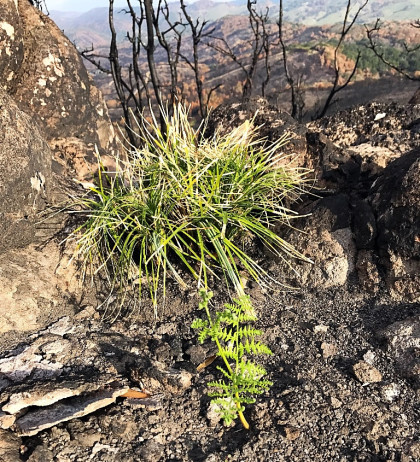Rejuvenated by fire

From the Sonoma Ecology Center: All around the Valley now, we’re seeing new sprouts from the branches and roots of fire-scarred oaks, madrones, toyons, and coyote brush. Grasses have transformed blackened ground to bright kelly green. (The photo above shows beargrass rising from its roots in the chaparral on Arrowhead Mountain.) And fire followers – native flowers that germinate after wildfire – are close behind.
In other words, the Valley is doing what it’s done for countless centuries after a fire. Given this swift regeneration, what can we do to help burned land?
The answer is simple. When it comes to burned areas that are away from roads, ditches, and buildings, most often the best response is just to watch and be amazed. The land is glad for these fires and knows how to respond. In these areas, our urge to “clean up” – in particular by cutting trees – can make the situation worse by leading to soil erosion and landslides. And putting equipment, vehicles, or too much foot traffic onto burned soils will crush germinating plants and compact the fluffy soil.
That’s why we’re advising all Sonoma Valley property owners: please do not cut downed any burned trees unless they pose a risk to life or property. Most will grow back from branches or roots, and the ones that don’t will serve as important native habitat. This is especially true of redwoods and of native hardwoods such as oaks, manzanitas, and madrones.
There are exceptions. Burned Douglas fir, or non-native trees such as eucalyptus and some conifers, may well need to come down. We also understand that some landowners may face irresistible pressure from insurance to cut and remove burned trees, even those that would recover.
Here are some ways to help the land now:
If you own Sonoma Valley property with burned man-made structures on it, please contact us right away. With your permission, our Emergency Watershed Protection Program will organize volunteers to isolate toxic ash and debris so it doesn’t wash away this winter to pollute the Valley’s soil or streams.
Another beneficial activity is to pinch off all but two or three of the sprouts on trees and shrubs, which will then grow faster with less crowding. And, if you steward land where invasive weeds like Himalayan blackberry or French broom burned, this could be a crucial time to make progress by keeping these invaders trimmed back until newly germinating natives can establish.
You can also observe and record the fascinating changes on your land or public land. For example, set up a nature camera, as Sonoma filmmaker Tim Wetzel did on behalf of Sonoma Ecology Center, and create time-lapse footage to watch the landscape turn from ashen to green. Water monitoring and bird watching are other options – contact us for help on any “citizen science” project you have in mind. Please help us spread the word on this important message



